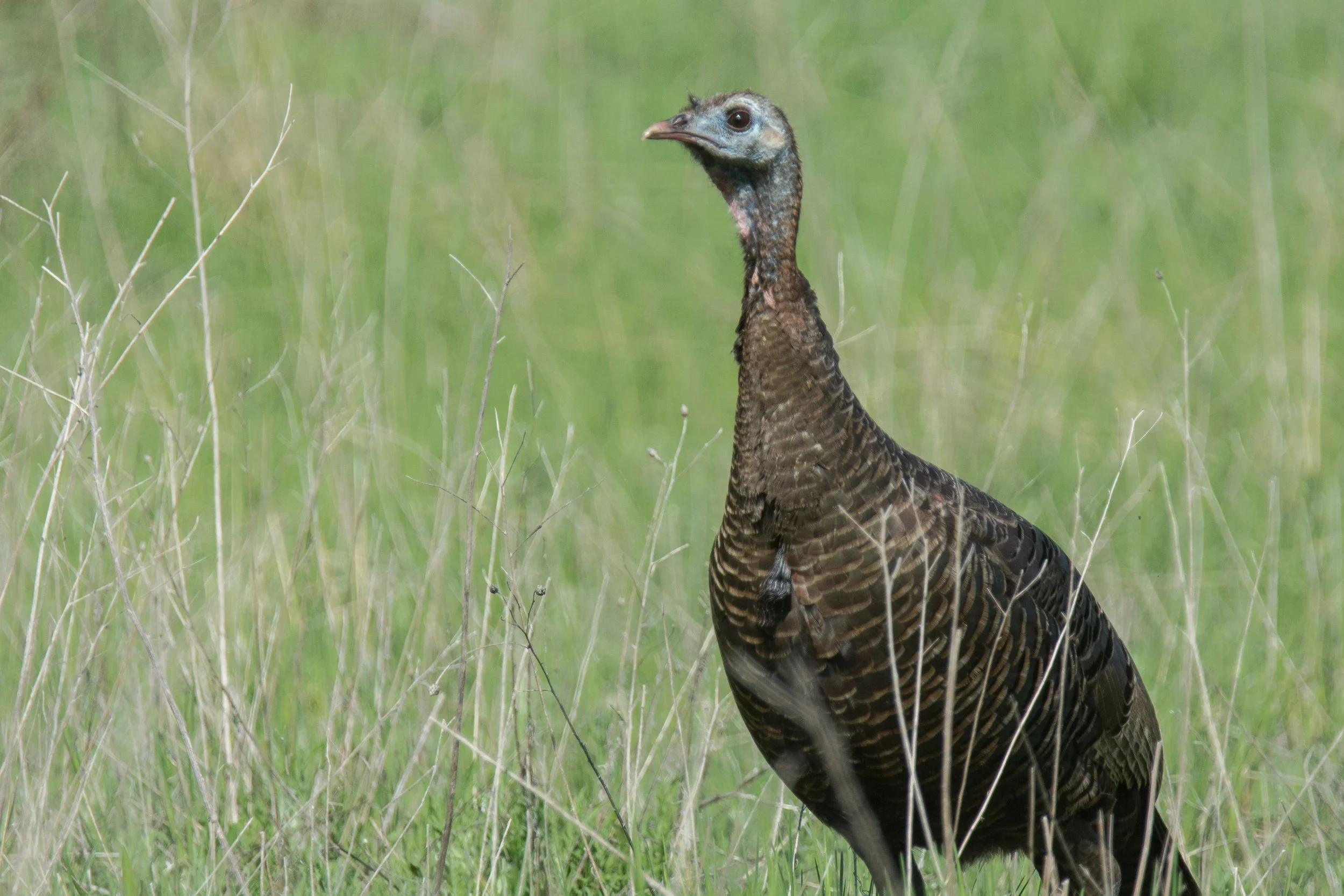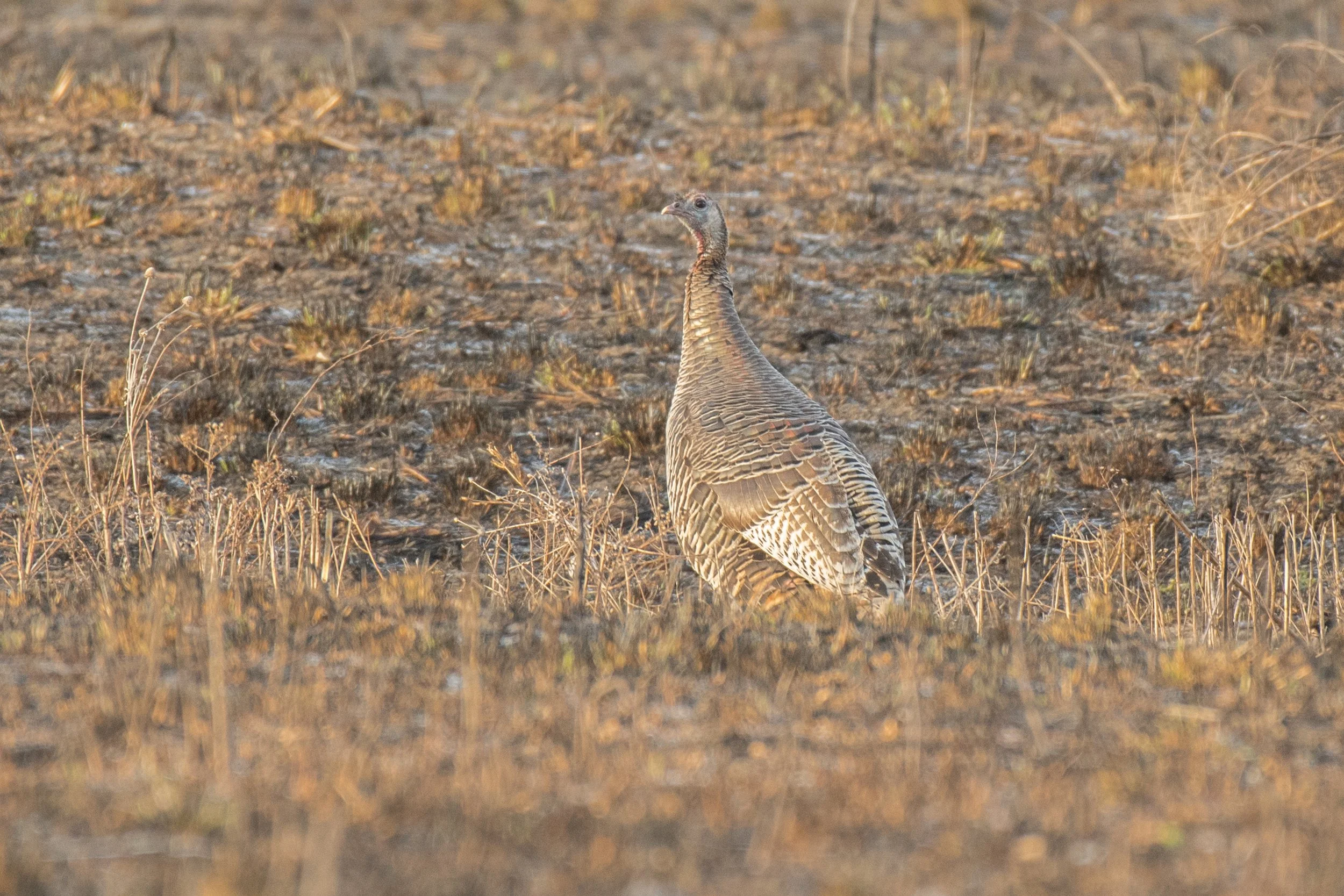Dan's Feathursday Feature: Wild Turkey
The name Wild Turkey does not evoke happy memories. It has something to do with a euchre all-nighter in college, my bad luck at cards, and shots of the eponymous rye whiskey after each game lost. The misery I experienced the next day was made all the worse by a five-hour drive to northern Michigan for the start of a three-day camping trip with the same “friends” at whose hands I had been overserved the previous evening.
With this essay I hope to make amends for the decades of ill will I’ve harbored toward the noble Wild Turkey. After all, the bird can’t be blamed for the misfortune of having its name attached to the rot-gut that did me in many years ago.
When speaking of the Wild Turkey, there is no need to spend time on ID fine points. It’s pretty hard to mis-identify a Wild Turkey. You probably will never hear anyone say: “I didn’t get a good look at its tail, so I’m not sure if it was a Wild Turkey or a Hermit Thrush.” You know it’s a turkey when you see one.
I prefer instead to spend a few lines to make the case that the Wild Turkey would have been a very appropriate choice as the national symbol of the U.S.A. Yes, I know that Benjamin Franklin purportedly argued as such more than two centuries ago, but he made his case based on the Wild Turkey’s apparent higher moral stature. My case is based on mistaken identity and mistakes rectified.
Here is a brief history of the Wild Turkey.
The year 20,000,000 BCE:
The natural process that led to the evolution of various species of what we now call game birds, such as the pheasant and the grouse, also gave rise to the ancestors of the turkey. Eventually two species of turkey would develop, both of them endemic to the American continent only.
About 20 million years later:
Sometime after 500 BCE, peoples indigenous to Mexico and Central America begin to domesticate the turkey. By 500 CE, the domesticated turkey is a staple of the people of the Mayan Empire.
About a thousand years later:
In 1519, Francisco Hernández de Córdoba arrives in the Yucatán from Cuba, the first European visitor to the Aztec territory ruled by Moctezuma II. Among the many fascinating items that Córdoba ships back to Spain are a few turkeys plucked from the barnyards of Mexico.
Very quickly these large, tasty fowl find their way to barnyards of the rich all over North Africa and Europe, replacing the peacock as the dinner of choice for royalty who want to put on the dog.
About 1525 the first domestic turkeys arrive in Britain. King Henry VIII is undoubtedly the first British monarch to fall asleep on the couch after feasting on roast turkey from the Americas.
But because of his dinner’s circuitous route from Mexico to the British Isles via Spain, North Africa and the Eastern Mediterranean, King Henry probably slumbered in blissful ignorance of the bird’s true origins. The British were already familiar with exotic imports like the African guinea fowl, which made their way to Britain on trade routes that passed through Turkey, and they referred to these sorts of exotic birds as turkey-fowl. When the turkey—which wasn’t called turkey yet, of course—started to arrive via the same trade route as the turkey-fowl, the Brits just assumed this was a new variety of the already familiar exotic fowls from south or east Asia.
Thus, the turkey comes to be called turkey.
Or something like that. I’d say there’s about a 50% chance that this story of how the turkey got its English name is true, but I have not found a better story, so I’m sticking with it.
Meanwhile, back in the good old future U.S. of A. turkeys are roving the forest fringes as they’ve done for millions of years, scraping for hickory nuts and beech nuts, blissfully ignorant that they are turkeys. The Cherokee call the bird gvna; to the Ojibwe of the Great Lakes region it is gichi-bine, which means large grouse. Taxonomically, the Ojibwe were closer to the truth than the Europeans were.
Early 1600s
The pilgrims land at Plymouth Rock. While that fabled origin story has a credibility potential of maybe 15%, we can be 99% certain that among the livestock the pilgrims unload from their ships are a few domestic turkeys, probably about the same number that Córdoba had sent to Spain from Mexico a century earlier. Imagine the pilgrims’ surprise when the gobbling of their turkeys attracts gvna from the surrounding forests. The endemic turkey may have served to strengthen their misconception that this new world was connected to the Far East, since that’s where turkeys came from, right? What exquisite irony to think that the Europeans’ erroneous understanding of the origin of the turkey possibly served as “evidence” of the fact that the earth is indeed round. Unfortunately, it took them many more years to figure out that there happens to be a huge continent between Europe and Asia, almost every square mile of it populated by turkey that have never set foot in Turkey.
1640 until today
The irony continues, tragically, as the “wheels of progress” grind slowly across North America. Over the next three hundred years, the turkey, which fed and enlightened indigenous peoples and immigrants alike, is slowly but surely extirpated—by rifle, by arrow, and by plow—from one territory after another. By the beginning of the 20th century there is serious concern that the Wild Turkey will follow the Passenger Pigeon on the road to extinction.
Fortunately for the Wild Turkey and for us, in the 1940s we humans begin to recognize the errors of our ways. Conservation groups, departments of natural resources, and hunting organizations begin programs of re-location and re-introduction to help the Wild Turkey gain footholds in areas where it had been wiped out. The Wild Turkey proved to be a very resilient and adaptable bird, and by the beginning of the current century every one of the lower forty-eight states is home to a healthy and growing population of Wild Turkey. The current population in North America is estimated to be 7.8 millions birds—ninety percent of them in the contiguous forty-eight, and the remainder in Mexico and Canada. There are probably more Wild Turkey in North America today—and in a broader range—than there were when the first waves of immigrants came from Europe. And the bird even has a whiskey named after it, for what that’s worth.
And so the Wild Turkey’s colorful history comes full circle. I will resist the temptation to draw pithy moral and historical conclusions, or get preachy about why I think the Wild Turkey should be our national bird. Let me just list a few descriptors that come to mind when I look at this wonderful bird’s twenty-million-year journey: misunderstood, underappreciated, underestimated, resilient, and ultimately vindicated. I am hard-pressed to find a bird with such an impressive array of traits, so intricately wrapped in the history of our nation, and so reflective of the collective experience of the diverse groups of people that comprise our multicultural society.
Mic drop.
Dan's Feathursday Feature is a regular contribution to the COS blog featuring the thoughts, insights and photography of Chicago birder, Dan Lory on birds of the Chicago region.






